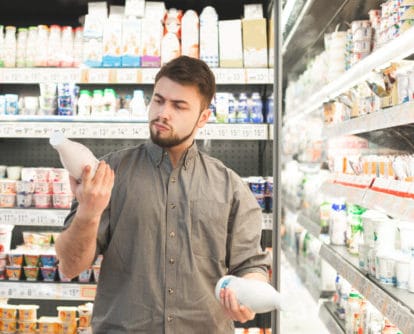Posted in Nutrition, Health Coaching
Basics of Reading Food Labels
With the overwhelming selection of packaged food items, it can be tough to navigate and select those that best suit our health. Here are some tips to keep in mind when reading food labels in order to make the best possible choices.
Serving Size/Servings Per Container
 This may seem like a no-brainer, but the food industry has become pretty sneaky when it comes to convincing you to fork over your hard-earned dollars for their products. In order to make the item appear “healthier,” they divide the bottle/box/package into multiple servings, so that they can list lower calories, sugar, fat, etc.
This may seem like a no-brainer, but the food industry has become pretty sneaky when it comes to convincing you to fork over your hard-earned dollars for their products. In order to make the item appear “healthier,” they divide the bottle/box/package into multiple servings, so that they can list lower calories, sugar, fat, etc.
I’m looking at a 20 oz. bottle of green tea right now and it’s listed as having 2.5 servings. Who’s going to divide that up into multiple servings…honestly? The difference is 18 grams of sugar versus 46 grams. If someone didn’t know any better or do the math, they would assume that it was 18 grams for the entire bottle.
Calories
Pretty self-explanatory. As you practice and become proficient at reading labels, you’ll notice if the calories seem reasonable for the given item.
Macronutrients (Fat/Carb/Protein)
This information is typically found directly below “Calories”. Let’s take a look at each of these individually.
- Fat – overall fat content will always be listed, however, depending on the product it may be subdivided even further into Saturated, Trans, Polyunsaturated, and/or Monounsaturated. Without going into great depth about the different fats, which are good, which are bad, etc., just remember that Trans fats are to be avoided at all costs.
- Carbs – when looking at the carbs label, you will almost always see “Sugars” listed. If the product has any Fiber, you’ll see that as well. I’ll address sugar and the body’s response in a future blog but the bottom line is to keep it to a minimum. Fiber, on the other hand, is something that we as a society are greatly lacking in our diets. You’re probably not going to get much quality fiber from a packaged item. Focus on veggies – they’re loaded with fiber!
- Protein – this is more or less a bonus number for you unless you’re an athlete or someone who’s tracking your protein intake very closely. Most folks get enough for the lifestyle they live.
Ingredients
 So this is where the rubber meets the road. Most packaged foods have so many fake foods, additives, preservatives, etc. that not only can we not pronounce them, we don’t have a clue as to what they even are. Guess what?? Our bodies don’t know either. Eating these “Frankenfoods” creates an autoimmune response in our bodies because what we’re consuming isn’t identified as food by our bodies.
So this is where the rubber meets the road. Most packaged foods have so many fake foods, additives, preservatives, etc. that not only can we not pronounce them, we don’t have a clue as to what they even are. Guess what?? Our bodies don’t know either. Eating these “Frankenfoods” creates an autoimmune response in our bodies because what we’re consuming isn’t identified as food by our bodies.
Make some homemade potatoes with cheese and you’re body knows what you’re giving it. On the flip side, “make” scalloped potatoes out of a box and you’re consuming garbage such as maltodextrin, sodium phosphate, monosodium glutamate (MSG), partially hydrogenated soybean oil (genetically modified food/trans fat), mono and diglycerides, silicon dioxide, artificial coloring (yellow 5 & 6), etc. See where I’m going with this?
It’s crucial that you read the ingredient list and remember: “If your mind doesn’t know what it is…chances are your body won’t either”.
Other Considerations
High Fructose Corn Syrup (HFCS)
High Fructose Corn Syrup is in probably around 80% of all packaged food items (if not more). This does NOT have the same response as regular sugar. It doesn’t need insulin to get itself out of the bloodstream – it can go directly to the liver, causing damage. Did you know that you can get sclerosis of the liver from sugar? There was a time when only alcohol was the culprit.
Trans Fats
As mentioned earlier these are HORRIBLE for our bodies. Unfortunately, there’s a loophole that food manufacturers have been using to their advantage. If the serving size has 0.4 grams or less of trans fat, the manufacturer can label it as zero. One way you can protect yourself is to read the ingredients. If it says “partially hydrogenated” anywhere in the list, it has trans fat.
Genetically Modified Organisms (GMO)
This is a hot topic right now. These are items that have been altered and/or created in a lab. There’s a battle going on to have GMO foods identified on our food labels but it’s an uphill battle. Some soy products will have a “Non-GMO” label on them.
Enriched
This is an easy one. Basically manufacturers process foods so much that they destroy the nutrients that the foods started with. Afterward, they put stuff back in or “enrich” it with vitamins, minerals, etc. Nothing is as good as what nature provided us to start with.
Monosodium Glutamate (MSG)
Wonder why some Chinese restaurants post that they don’t use MSG? Because it’s bad for us. Yes, it can make things taste better (also known as hyper-palatability), much like salt can, however, it’s a toxin to our brains and can potentially cause serious side effects. Guess what…it’s still in many packaged food items. Read the ingredients!
Tricky Marketing
 One of my favorite scams is when manufacturers put beautiful pictures of fruits and vegetables on the container but upon further investigation, it has minimal to NO fruits or veggies in it. It’s disgraceful and misleading.
One of my favorite scams is when manufacturers put beautiful pictures of fruits and vegetables on the container but upon further investigation, it has minimal to NO fruits or veggies in it. It’s disgraceful and misleading.
Lastly, I’d encourage you to take notice of where grocery stores place certain items. The colorful cereals with cartoon characters “magically” appear lower on the shelves – within the grasp a child. I know that doesn’t have anything to do with reading labels, but I want you to become aware that the food industry knows what it’s doing.
While the above-mentioned list may seem overwhelming, I can assure you that with a little practice that reading labels will become second nature to you. Ultimately the best thing to do when shopping for food is to stay along the outside perimeter of the grocery store. There you’ll find most of the food as nature intended it to be. You’ll look and feel so much better!
What best practices do you have? Drop me a message on social media!
If you need help navigating the world of nutrition, I offer an online health coaching program where we walk through a manageable and custom approach for you to shift to a healthier approach. Drop me a line if interested.
You may also enjoy these articles...

Coconut Oil – Friend or Foe?
As with so many things in life this once popular oil has made a comeback. Of course in some parts of the world, coconut oil never fell out of popularity. This amazing food is extremely

4 Strategies to Implement a Healthier Lifestyle
You’ve been through this before…you’ve made the same promise to yourself – “I’m going to eat better.” If you hold the thought longer than a minute you may even make it so far as to

There’s No Perfect Time
Today I wanted to share something that happened to me. It wasn’t anything blatantly earth-shattering or in-your-face. In fact, it was merely a series of thoughts that ran through my mind. Thoughts that occur every